Effective and Affordable Methodologies for the Optical Characterization of Envelope Materials Within Urban Contexts
Abstract
1. Introduction
2. Objectives
- The evaluation of in situ optical response of opaque coatings used on urban building envelopes, focusing on a case study within a social housing neighborhood in the Mendoza Metropolitan Area, Argentina. The collected data will contribute to the development of strategies for improved building and urban energy efficiency, specifically through the creation of representative models.
- The assessment of the scope of methodologies and instruments used for the in situ optical characterization of materials, since their reliability may be constrained with respect to those obtained in a laboratory setting. In particular, field measurements are subject to uncontrolled variations in temperature and humidity conditions, as well as the presence of pollutants and/or dust in the environment and the necessary movement of equipment to characterize different materials. Firstly, the reliability of the results obtained from the characterization must be evaluated, particularly in the case of materials with geometrically complex and non-homogeneous surfaces. Secondly, the reliability of low-cost methodologies and instruments that allow this characterization to be carried out in every socioeconomic context must be evaluated.
3. Materials and Methods
3.1. Study Area
3.2. Optical Properties Analyzed
- Color coordinates have been defined in CIELab space, which is a uniform color space intended to represent perceived threshold or suprathreshold color differences of equal size [24]. It is one of the most widely used color spaces in the industry. Typical applications include color specification and color difference assessment. The CIELAB color system, also known as CIE L*a*b*, provides a quantitative representation of color relationships across three axes: The L* value indicates the lightness, while a* and b* represent the chromaticity coordinates. In the color space diagram, L* is represented on a vertical axis with values from 0 (black) to 100 (white). The a* value indicates the red–green component of a color, with positive and negative values representing the red and green components, respectively. The yellow and blue components are represented on the b* axis as positive and negative values, respectively. The neutral or achromatic point is located at the center of the plane [25]. In order to determine the color coordinates, it is necessary to define both the observer and the standard illuminant.
- Total hemispherical emittance (HTE) is the total radiant power emitted by a surface per unit area and per unit solid angle in a given direction.
3.3. Equipment and Methodologies
- Solar reflectance (r_sol) and visible reflectance (r_vis): are determined from reflectance spectra measured with modular Stellarnet equipment consisting of a radiation source and two spectrometers. The source is a tungsten–halogen lamp with a spectral range of 350 nm to 2200 nm, a power output of 200 W/m2, and an optical color temperature of around 2800 K, including a color equalizer filter. The Black Comet spectrometer provides detection in the 200–1080 nm range with a concave grating optics, having no mirrors or optical adjustments, and a 2048-pixel CCD detector. An internal slit with a size of 50 µm gives rise to an estimated resolution of 2.0 nm. The Dwarf Star spectrometer provides detection in the 900–1700 nm range with a 512-pixel Peltier-cooled InGaAs detector. The resolution is 2.5 nm with a slit width of 25 μm. The equipment’s measurement range combining the different modules is from 350 to 1700 nm, which covers over 95% of solar energy, though it does not span the full wavelength range of 200 to 2500 nm (Equation (1)). The reflectance is measured using a probe comprising seven illumination optical fibers encircling a central reflected radiation measurement fiber. The probe can be housed in a fixture that allows the angle of incidence of the radiation to be defined as either 45° with respect to the sample surface (more suitable for samples with a glossy finish) or 90° (more suitable for a matte finish). The geometry of the measurement is not as reliable as the one based in integrating spheres usual in laboratory equipment. However, unlike the laboratory configurations, the probe used provides the higher signal and lower measuring times that are necessary for in situ characterization. Different strategies are implemented to improve the reliability of the measurement results. It is essential to optimize the distance between the probe tip and the surface to be measured and fix it along the measurements for each configuration in order to obtain the maximum signal in the spectrometer. The various components of the equipment are linked via single or bifurcated optical fibers of varying diameters, contingent on the signal in question. To calibrate the equipment, the zero signal is defined by covering the radiation output of the source with a mask. This process eliminates the need to turn off the radiation source at each calibration, which would otherwise result in a loss of signal stability. Calibration is completed using a Spectralon standard with a reflectance value (mostly diffuse) greater than 97% over the entire measurement range of the instrument. It is important to note that the reflectance measurement may be affected if there is significant movement of the optical fibers. Therefore, it is advisable to perform the calibration with the standard placed on the surface to be measured and to avoid unnecessary movement during measurement. This condition implies the need to repeat the calibration for each material in the case of in situ measurements such as those presented in this study. It is also important to note that the reflectance values obtained are relative to the reflectance of the Spectralon standard. Consequently, the accuracy of the results depends on the accuracy of the reflectance values of the standard and will be affected by the aging of its surface. Field measurements are carried out under poorly controlled conditions, which in many cases lead to degradation of the standard. To improve the accuracy of the results without investing in costly periodic calibrations by accredited bodies, standards used for field measurements are often calibrated against an unaged calibrated standard stored under stable conditions.
- CIELab color coordinates are determined from reflectance spectra measured with the Stellarnet Black Comet spectrometer, in accordance with the CIE 1964 Standard Observer and D65 Illuminant. The results obtained with this instrumentation will be compared with those produced by the NR20XE 3nh precision colorimeter, which complies with the “CIE 15: Technical Report: Colorimetry” that considers the CIE 1964 Standard Observer and D65 Illuminant [26]. The colorimeter has a repeatability of ΔE*ab 0.08 with a measuring aperture of Φ20 mm (Figure 4).
- Emissivity (ε) is measured with a portable emissivity meter (ET100 with SOC410 unit) from Surface Optics Corporation, which complies with ASTM E408-19 [27]. The ET100 measures total directional emittance by directing radiation onto a surface in a specific direction and collecting the reflected radiation in all directions. This instrument features a measuring head based on a modified integrating sphere with an internal gold coating. The instrument is calibrated with a specular gold standard and records the total directional reflectance for angles of incidence of 20° and 60° in six discrete bands in the infrared spectral region: 1.9–2.4, 3.0–3.9 µm (mid IR), 4.0–5.0, 5.0–10.0, and 10.0–21.0 µm (long IR) using six combined filters. Based on these measurements, it determines the total directional emittance at these angles of incidence. Additionally, it calculates the total hemispherical emittance (HTE) using the measurements taken at 20°. The declared accuracy of the emissivity measurements is ±0.03.
4. Results
4.1. Optical Response of Opaque Urban Materials
4.1.1. Cluster Analysis of Solar and Visible Reflectance
4.1.2. Color Coordinates
4.1.3. Emissivity Analysis
4.2. Reliability Analysis of In Situ Characterization Results
4.2.1. Estimation of Spectral Reflectance in Non-Homogeneous Materials
4.2.2. Estimation of Emissivity with the Portable Instrument ET 100
4.3. Contrasting Results Obtained with Low- and High-Complexity Instrumentation
4.3.1. Color Coordinates with Spectrometer vs. Colorimeter
4.3.2. Linear Regression Models of Solar Reflectance
5. Discussion
Urban Retrofitting Strategies Based on the Thermo-Optical Behavior of Opaque Materials
6. Conclusions
Author Contributions
Funding
Data Availability Statement
Acknowledgments
Conflicts of Interest
References
- López-García, E.; Lizana, J.; Serrano-Jiménez, A.; Díaz-López, C.; Barrios-Padura, Á. Monitoring and analytics to measure heat resilience of buildings and support retrofitting by passive cooling. J. Build. Eng. 2022, 57, 104985. [Google Scholar] [CrossRef]
- Santamouris, M.; Paolini, R.; Haddad, S.; Synnefa, A.; Garshasbi, S.; Hatvani-Kovacs, G.; Gobakis, K.; Yenneti, K.; Vasilakopoulou, K.; Feng, J.; et al. Heat mitigation technologies can improve sustainability in cities. An holistic experimental and numerical impact assessment of urban overheating and related heat mitigation strategies on energy consumption, indoor comfort, vulnerability and heat-related mortality and morbidity in cities. Energy Build. 2020, 217, 110002. [Google Scholar] [CrossRef]
- Akbari, H.; Lodi, C.; Muscio, A.; Tartarini, P. Analysis of a new index for the thermal performance of horizontal opaque building components in summer. Atmosphere 2021, 12, 862. [Google Scholar] [CrossRef]
- Santamouris, M. Environmental Design of Urban Buildings: An Integrated Approach; Routledge: Abingdon, UK, 2006. [Google Scholar]
- Bui, D.K.; Nguyen, T.N.; Ghazlan, A.; Ngo, N.T.; Ngo, T.D. Enhancing building energy efficiency by adaptive façade: A computational optimization approach. Appl. Energy 2020, 265, 114797. [Google Scholar] [CrossRef]
- Levinson, R. Using solar availability factors to adjust cool-wall energy savings for shading and reflection by neighboring buildings. Sol. Energy 2019, 180, 717–734. [Google Scholar] [CrossRef]
- Taha, H.; Sailor, D.; Akbari, H. High-Albedo Materials for Reducing Building Cooling Energy Use; University of California: Berkeley, CA, USA, 1992. [Google Scholar] [CrossRef]
- Santamouris, M.; Synnefa, A.; Karlessi, T. Using advanced cool materials in the urban built environment to mitigate heat islands and improve thermal comfort conditions. Sol. Energy 2011, 85, 3085–3102. [Google Scholar] [CrossRef]
- Falasca, S.; Ciancio, V.; Salata, F.; Golasi, I.; Rosso, F.; Curci, G. High albedo materials to counteract heat waves in cities: An assessment of meteorology, buildings energy needs and pedestrian thermal comfort. Build. Environ. 2019, 163, 106242. [Google Scholar] [CrossRef]
- Miller, W.; Machard, A.; Bozonnet, E.; Yoon, N.; Qi, D.; Zhang, C.; Liu, A.; Sengupta, A.; Akander, J.; Hayati, A.; et al. Conceptualising a resilient cooling system: A socio-technical approach. City Environ. Interact. 2021, 11, 100065. [Google Scholar] [CrossRef]
- Martín-Consuegra, F.; De Frutos, F.; Hernández-Aja, A.; Oteiza, I.; Alonso, C.; Frutos, B. Utilización de datos catastrales para la planificación de la rehabilitación energética a escala urbana: Aplicación a un barrio ineficiente y vulnerable de Madrid. Ciudad. Territ. Estud. Territ. 2021, 54, 115–136. [Google Scholar] [CrossRef]
- Klinenberg, E. Heat Wave a Social Autopsy of Disaster in Chicago; University of Chicago Press: Chicago, IL, USA, 2022; Available online: https://www.perlego.com/book/1853205/heat-wave-a-social-autopsy-of-disaster-in-chicago-pdf (accessed on 17 February 2025).
- Kalkstein, L.; Klink, F.; Shickman, K.; Schneider, S.; Egolf, M.; Sailor, D. The Potential Impact of Cool Roof Technologies upon Heat Wave Meteorology and Human Health in Boston and Chicago. In Roofing Research and Standards Development: 9th Volume; ASTM International: West Conshohocken, PA, USA, 2020; pp. 1–27. [Google Scholar] [CrossRef]
- Villalba, A.; Alchapar, N.; Correa, E.; Pattini, A.; Santoni, L. Métodos de evaluación opto-térmica de materiales y componentes de la envolvente edilicia. Situación en Argentina. Rev. Hábitat Sustentable 2018, 8, 64–79. [Google Scholar] [CrossRef]
- Pérez, G.; Martín-Consuegra, F.; Martínez, A.; Alonso, C.; de Frutos, F.; Guerrero Bustos, A.M. Medidas de Reflectancia Solar y Emisividad de Materiales Urbanos. Fiabilidad de las Medidas In-Situ con Equipos Portátiles. Congreso Español de Metrología. 2022, pp. 1–9. Available online: https://digital.csic.es/bitstream/10261/296434/1/Medidas%20de%20reflectancia%20solar%20y%20emisividad%20de%20materiales%20urbanos.pdf (accessed on 17 February 2025).
- Pérez, G.; Martín-Consuegra, F.; de Frutos, F.; Martínez, A.; Oteiza, I.; Frutos, B.; Alonso, C. Analysis of the Optical Response of Opaque Urban Envelope Materials: The Case of Madrid. Infrastructures 2022, 7, 116. [Google Scholar] [CrossRef]
- Thoreau, R.; Risser, L.; Achard, V.; Berthelot, B.; Briottet, X. Toulouse Hyperspectral Data Set: A benchmark data set to assess semi-supervised spectral representation learning and pixel-wise classification techniques. ISPRS J. Photogramm. Remote Sens. 2024, 212, 323–337. [Google Scholar] [CrossRef]
- Alchapar, N.; Correa, E.; Cantón, M. Classification of building materials used in the urban envelopes according to their capacity for mitigation of the urban heat island in semiarid zones. Energy Build. 2014, 69, 22–32. [Google Scholar] [CrossRef]
- Alchapar, N.; Correa, E. Optothermal properties of façade coatings. Effects of environmental exposure over solar reflective index. J. Build. Eng. 2020, 32, 101536. [Google Scholar] [CrossRef]
- Sen, S.; Roesler, J. Thermal and optical characterization of asphalt field cores for microscale urban heat island analysis. Constr. Build. Mater. 2019, 217, 600–611. [Google Scholar] [CrossRef]
- Sanjuán, M.Á.; Morales, Á.; Zaragoza, A. Effect of Precast Concrete Pavement Albedo on the Climate Change Mitigation in Spain. Sustainability 2021, 13, 11448. [Google Scholar] [CrossRef]
- Sailor, D.J.; Resh, K.; Segura, D. Field measurement of albedo for limited extent test surfaces. Sol. Energy 2006, 80, 589–599. [Google Scholar] [CrossRef]
- Levinson, R.; Akbari, H. Effects of composition and exposure on the solar reflectance of portland cement concrete. Cem. Concr. Res. 2002, 32, 2001–2002. [Google Scholar] [CrossRef]
- Luo, M.R. CIELAB BT—Encyclopedia of Color Science and Technology; Luo, R., Ed.; Springer: Berlin/Heidelberg, Germany, 2014; pp. 1–7. [Google Scholar] [CrossRef]
- Ly, B.; Dyer, E.; Feig, J.; Chien, A.; Del Bino, S. Research Techniques Made Simple: Cutaneous Colorimetry: A Reliable Technique for Objective Skin Color Measurement. J. Investig. Dermatol. 2020, 140, 3–12.e1. [Google Scholar] [CrossRef] [PubMed]
- International Commission on Illumination (CIE). CIE 15: Technical Report: Colorimetry, 3rd ed.; Vienna, Austria, 2004; ISBN 978 3 901906 33 6. [Google Scholar]
- ASTM E408-09; Standard Test Methods for Total Normal Emittance of Surfaces Using Inspection-Meter Techniques. ASTM International: West Conshohocken, PA, USA, 2009.
- Akbari, H.; Levinson, R.; Stern, S. Procedure for measuring the solar reflectance of flat or curved roofing assemblies. Sol. Energy 2008, 82, 648–655. [Google Scholar] [CrossRef]
- White, M.; Hu, Y.; Langenheim, N.; Ding, W.; Burry, M. Cool city design: Integrating real-time Urban canyon assessment into the design process for chinese and Australian cities. Urban Plan. 2016, 1, 25–37. [Google Scholar] [CrossRef]
- Hasan, M.; Islam, A. Kabir, M. A Comprehensive Survey on Distance Based Machine Learning Algorithms. J. Artif. Intell. 2016, 9, 1–54. [Google Scholar]
- ASTM 1918-21; Standard Test Method for Measuring Solar Reflectance of Horizontal and Low-Sloped Surfaces in the Field. ASTM International: West Conshohocken, PA, USA, 2021.
- Taylor, S.; Wright, J.; Forrest, E.; Jared, B.; Koepke, J.; Beaman, J. Investigating relationship between surface topography and emissivity of metallic additively manufactured parts. Int. Commun. Heat. Mass. Transf. 2020, 115, 104614. [Google Scholar] [CrossRef]
- Salvati, A.; Kolokotroni, M.; Kotopouleas, A.; Watkins, R.; Giridharan, R.; Nikolopoulou, M. Impact of reflective materials on urban canyon albedo, outdoor and indoor microclimates. Build. Environ. 2022, 207, 108459. [Google Scholar] [CrossRef]
- Tsoka, S.; Tsikaloudaki, K.; Theodosiou, T.; Bikas, D.; Tsikaloudaki, A.; Theodosiou, T. Urban warming and cities’ microclimates: Investigation methods and mitigation strategies—A review. Energies 2020, 13, 1414. [Google Scholar] [CrossRef]
- Khorat, S.; Das, D.; Khatun, R. Cool roof strategies for urban thermal resilience to extreme heatwaves in tropical cities. Energy Build. 2024, 302, 113751. [Google Scholar] [CrossRef]
- Xu, F.; Zhang, J.; Gao, Z. The effect of building surface cool and super cool materials on microclimate in typical residential neighborhoods in Nanjing. Sustain. Cities Soc. 2023, 98, 104838. [Google Scholar] [CrossRef]
- Santamouris, M. Cooling the cities—A review of reflective and green roof mitigation technologies to fight heat island and improve comfort in urban environments. Sol. Energy 2014, 103, 682–703. [Google Scholar] [CrossRef]
- Morini, E.; Castellani, B.; Presciutti, A.; Filipponi, M.; Nicolini, A.; Rossi, F. Optic-energy performance improvement of exterior paints for buildings. Energy Build. 2017, 139, 690–701. [Google Scholar] [CrossRef]
- Wang, N.; Lv, Y.; Zhao, D.; Zhao, W.; Xu, J.; Yang, R. Performance evaluation of radiative cooling for commercial-scale warehouse. Mater. Today Energy 2022, 24, 100927. [Google Scholar] [CrossRef]
- Alonso, C.; Martín-Consuegra, F.; Oteiza, I.; Asensio, E.; Pérez, G.; Martínez, I.; Frutos, B. Effect of façade surface finish on building energy rehabilitation. Sol. Energy 2017, 146, 470–483. [Google Scholar] [CrossRef]
- Pisello, A.; Taylor, J.; Xu, X.; Cotana, F. Inter-building effect: Simulating the impact of a network of buildings on the accuracy of building energy performance predictions. Build. Environ. 2012, 58, 37–45. [Google Scholar] [CrossRef]
- Alchapar, N.; Correa, E. The use of reflective materials as a strategy for urban cooling in an arid “OASIS” city. Sustain. Cities Soc. 2016, 27, 1–14. [Google Scholar] [CrossRef]
- Suk, J.; Schiler, M.; Kensek, K. Reflectivity and specularity of building envelopes: How materiality in architecture affects human visual comfort. Archit. Sci. Rev. 2017, 60, 256–265. [Google Scholar] [CrossRef]
- Córica, M.; Ruiz, M. Aspectos cuantitativos y cualitativos de la luz solar en recintos urbanos de alta densidad edilicia en climas soleados (período invernal). Rev. Hábitat Sustentable 2018, 8, 16–27. [Google Scholar] [CrossRef]
- Córica, M.; Ruiz, M. Luz solar en recintos urbanos de alta densidad edilicia en el modelo oasis de la ciudad de Mendoza. Aspectos cuantitativos y cualitativos (período estival). Cuad. Urbano 2018, 25, 117–138. [Google Scholar] [CrossRef][Green Version]
- Corica, L.; Pattini, E. Natural en cañones urbanos de la ciudad de mendoza, evaluation of the component reflected of daylight in urban environments. Energías Renov. Medio Ambient. 2011, 28, 9–16. [Google Scholar]
- Synnefa, A.; Santamouris, M.; Akbari, H. Estimating the effect of using cool coatings on energy loads and thermal comfort in residential buildings in various climatic conditions. Energy Build. 2007, 39, 1167–1174. [Google Scholar] [CrossRef]
- Castellani, B.; Morini, E.; Anderini, E.; Filipponi, M.; Rossi, F. Development and characterization of retro-reflective colored tiles for advanced building skins. Energy Build. 2017, 154, 513–522. [Google Scholar] [CrossRef]
- Xue, X.; Yang, Z.; Li, Y.; Sun, P.; Feng, Y.; He, Z.; Qu, T.; Dai, J.G.; Zhang, T.; Qin, J.; et al. Superhydrophobic self-cleaning solar reflective orange-gray paint coating. Sol. Energy Mater. Sol. Cells 2018, 174, 292–299. [Google Scholar] [CrossRef]
- Li, W.; Shi, Y.; Chen, Z.; Fan, S. Photonic thermal management of coloured objects. Nat. Commun. 2018, 9, 4240. [Google Scholar] [CrossRef]
- Mandal, J.; Fu, Y.; Overvig, A.; Jia, M.; Sun, K.; Shi, N.N.; Zhou, H.; Xiao, X.; Yu, N.; Yang, Y. Hierarchically porous polymer coatings for highly efficient passive daytime radiative cooling. Science 2018, 362, 315–319. [Google Scholar] [CrossRef] [PubMed]
- Zhai, Y.; Ma, Y.; David, S.; Zhao, D.; Lou, R.; Tan, G.; Yang, R.; Yin, X. Scalable-manufactured randomized glass-polymer hybrid metamaterial for daytime radiative cooling. Science 2017, 355, 1062–1066. [Google Scholar] [CrossRef] [PubMed]
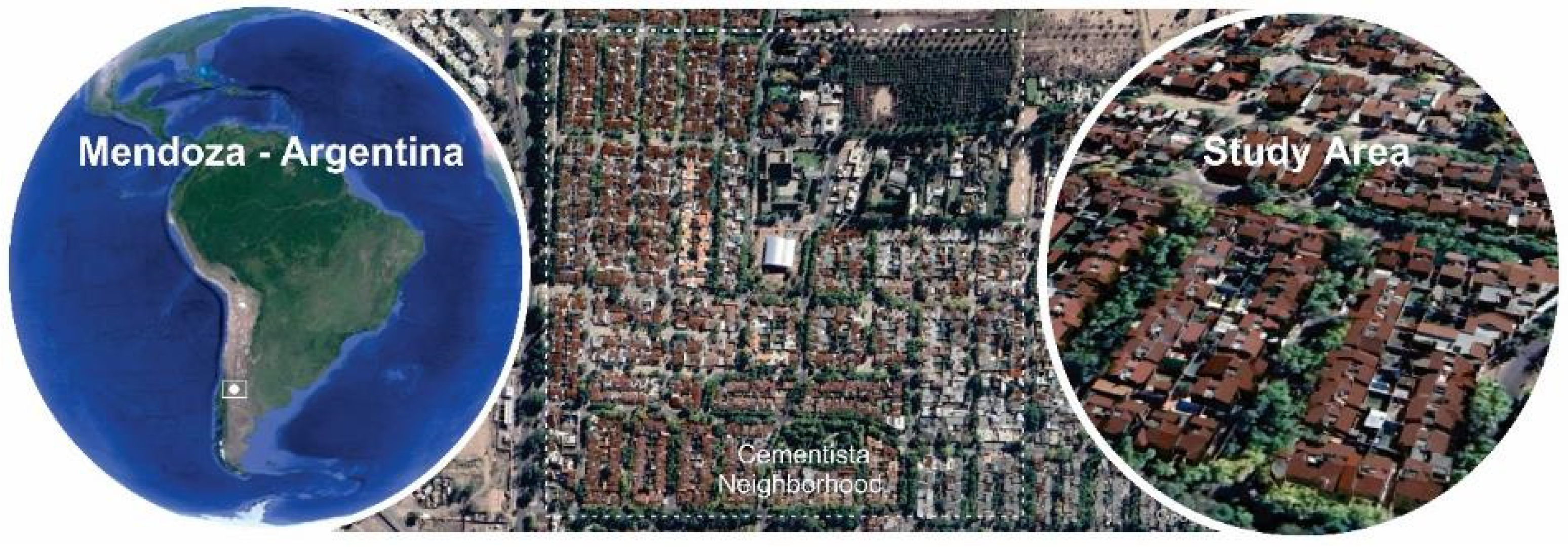
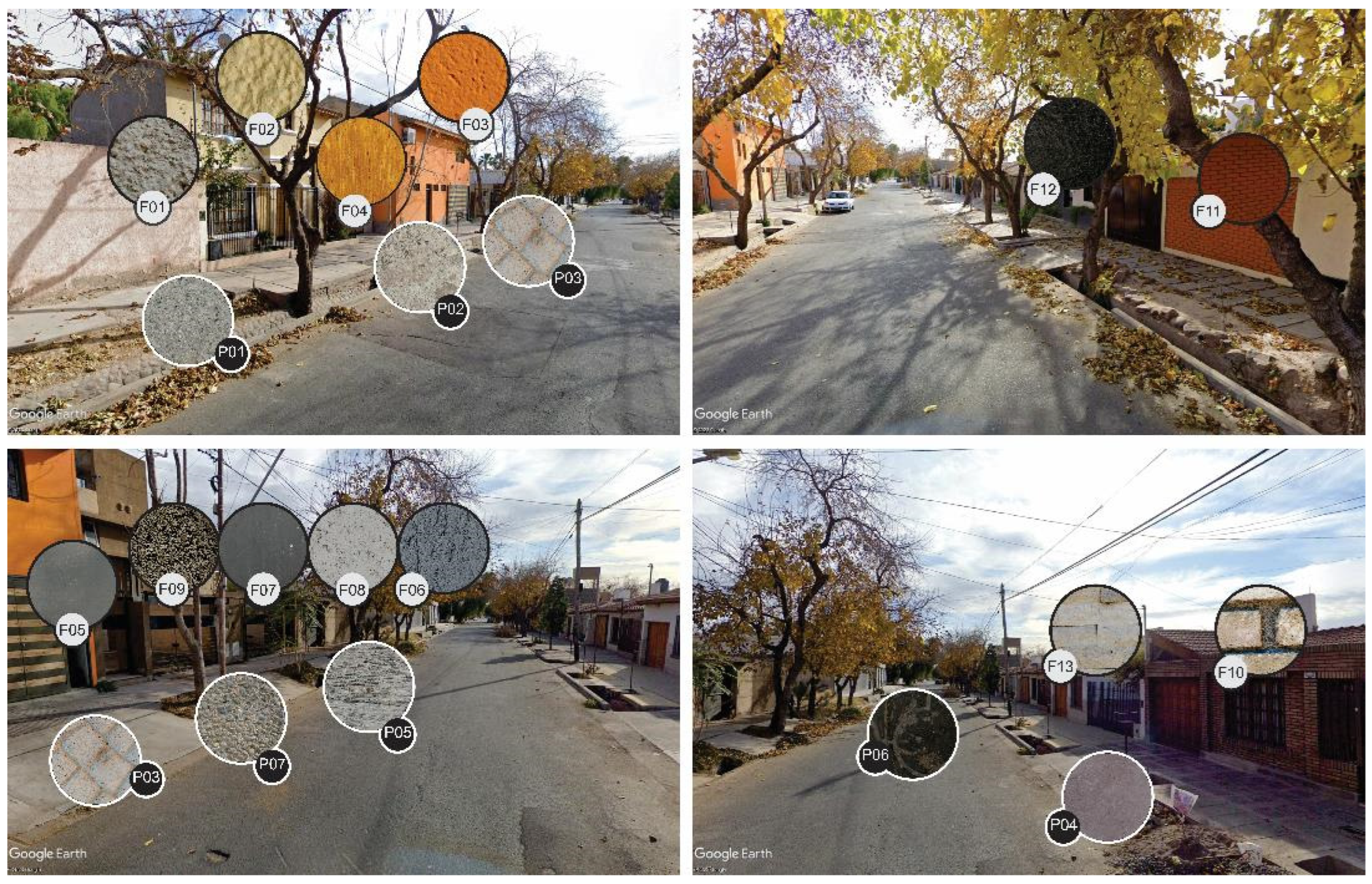


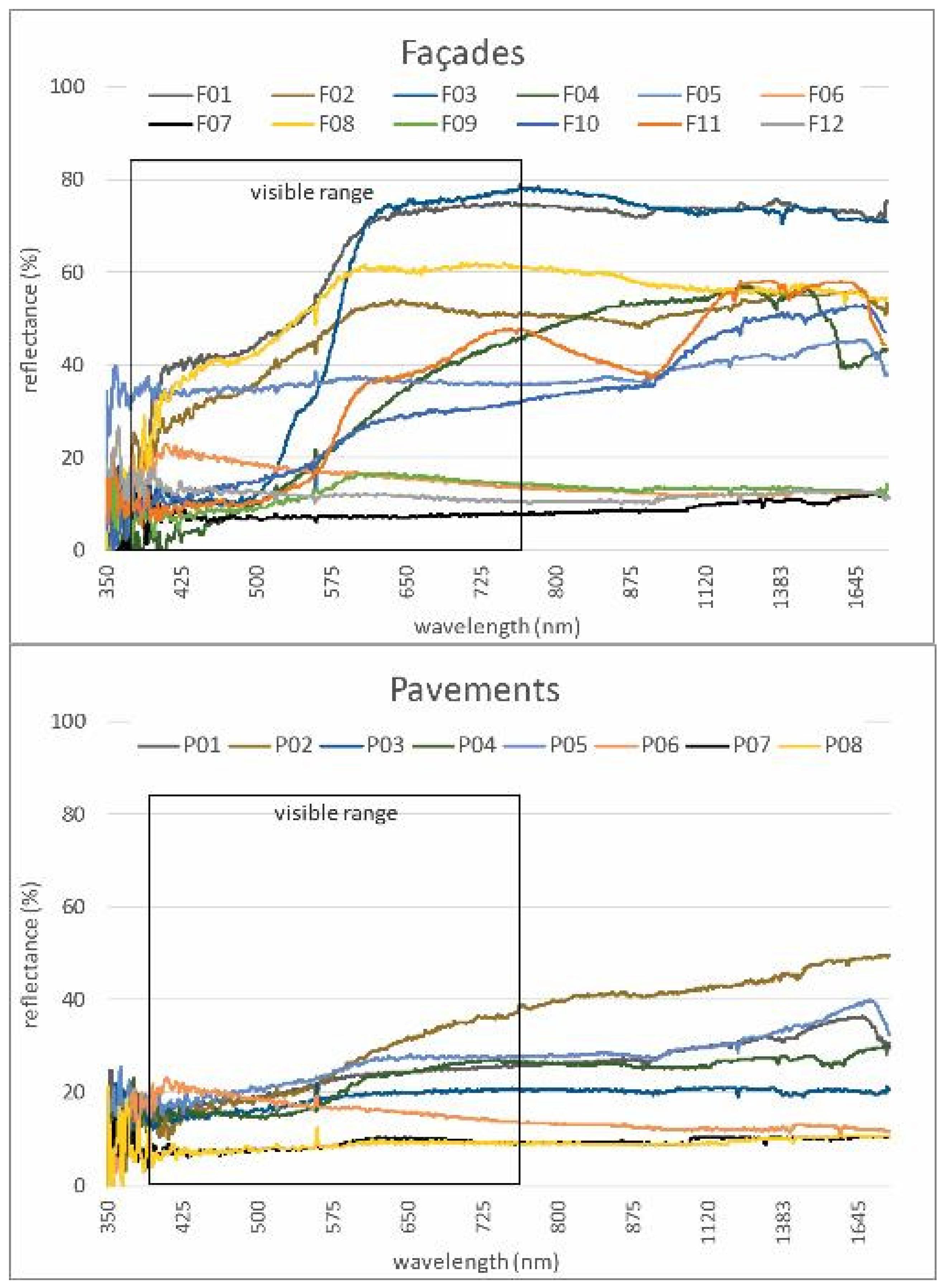


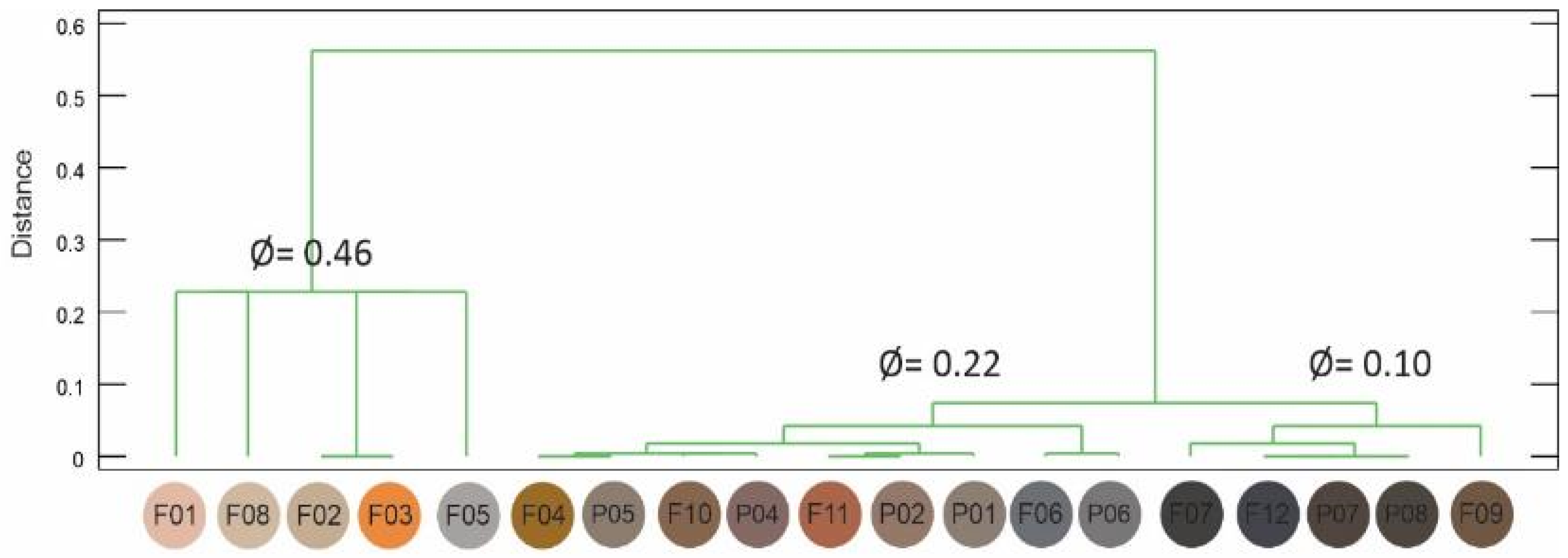

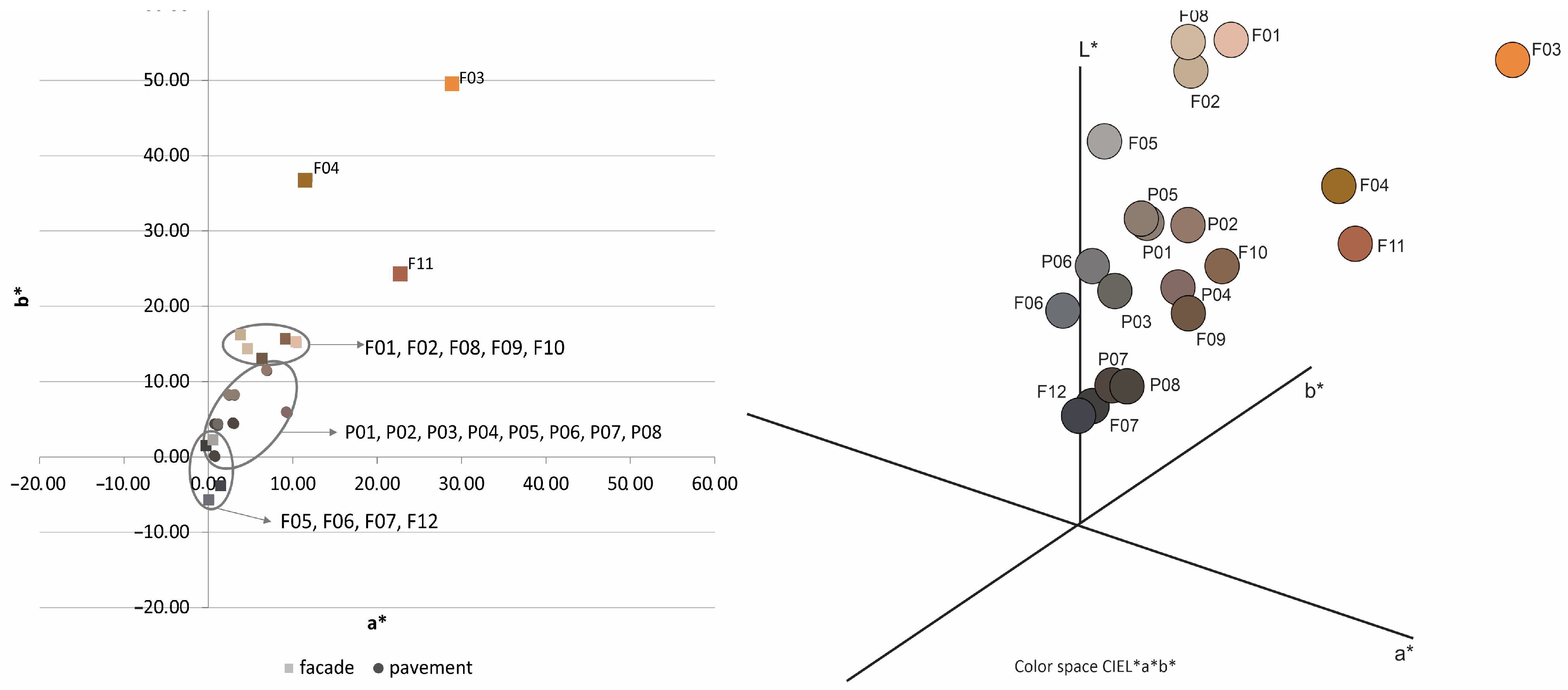
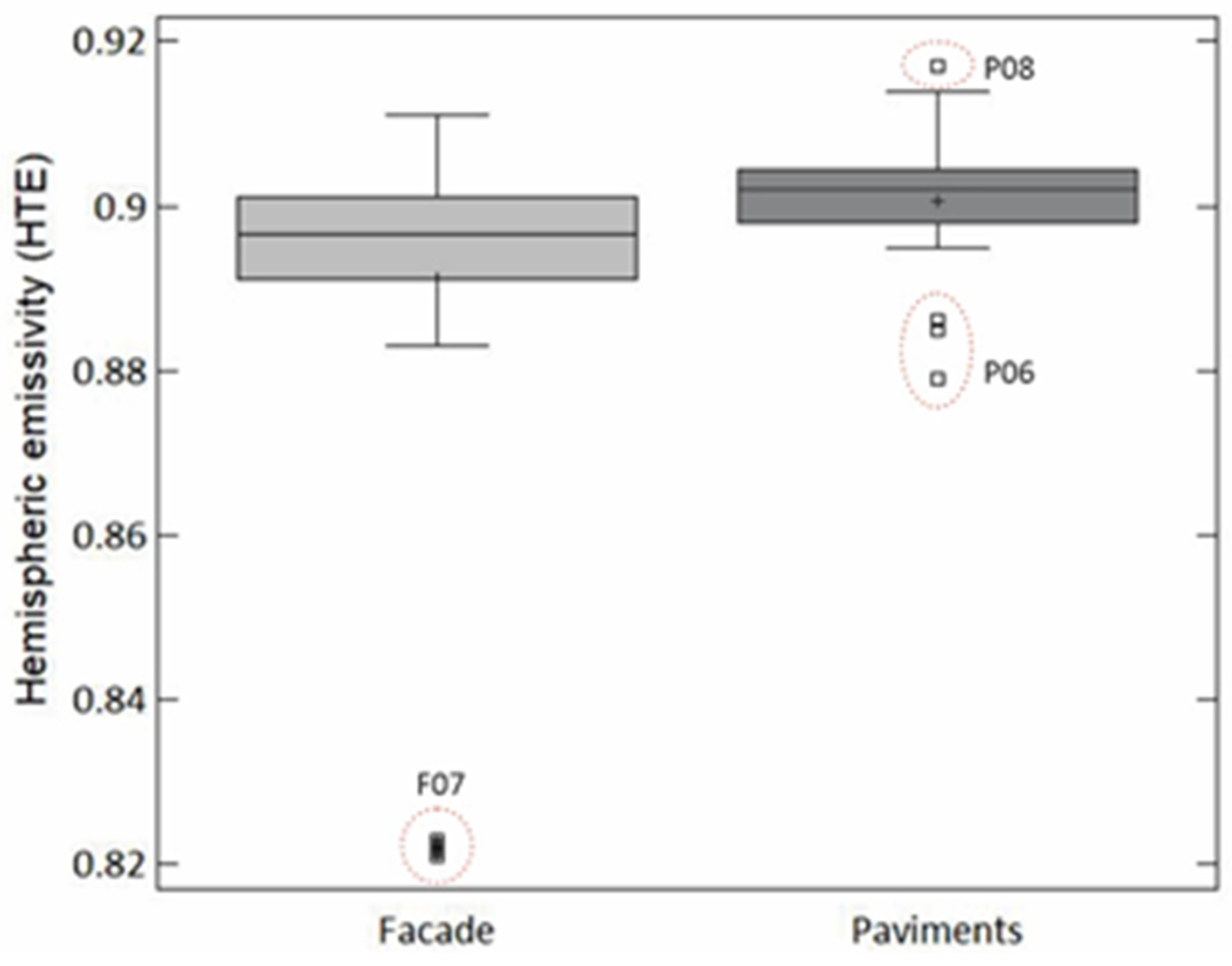
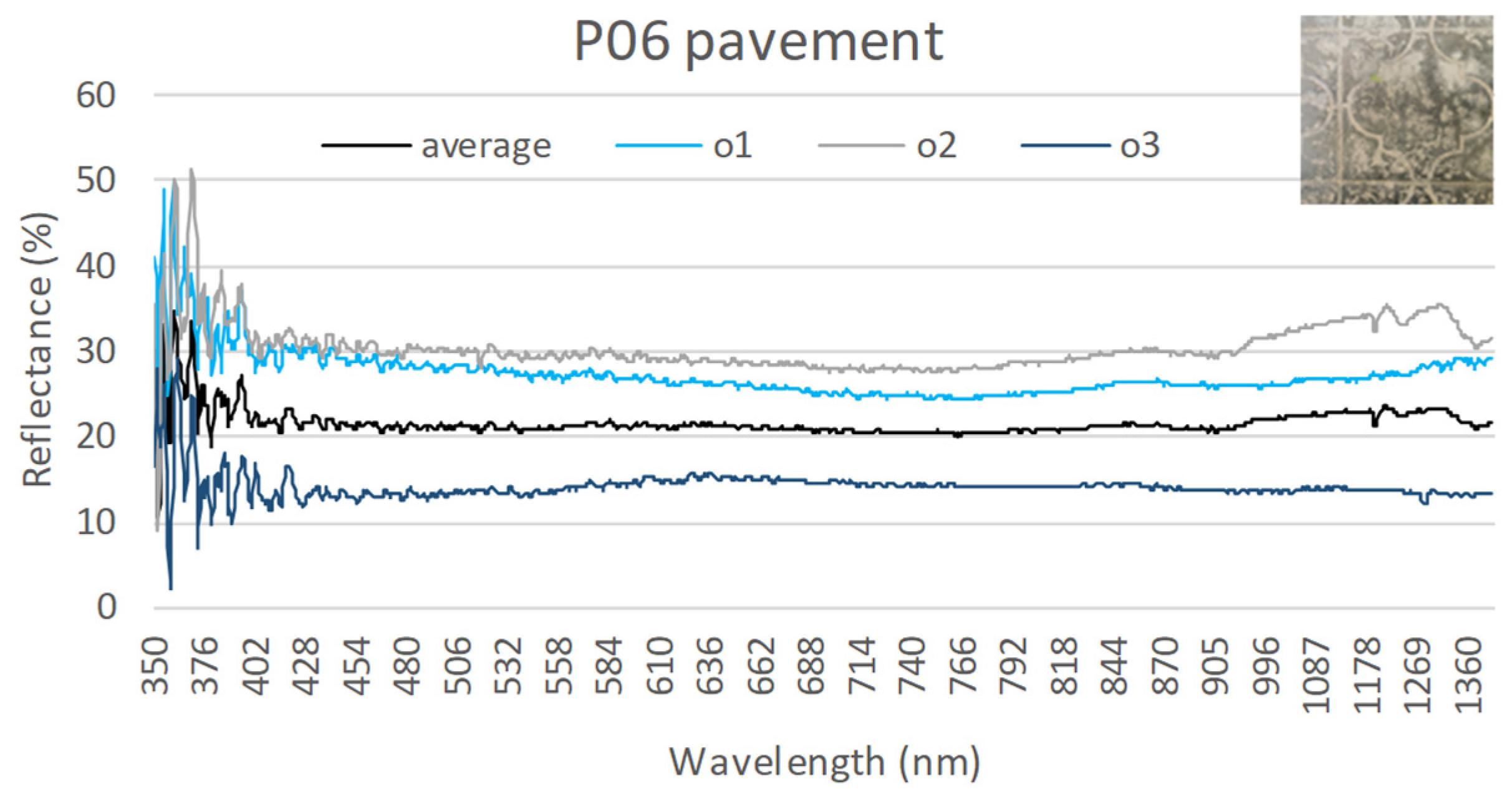
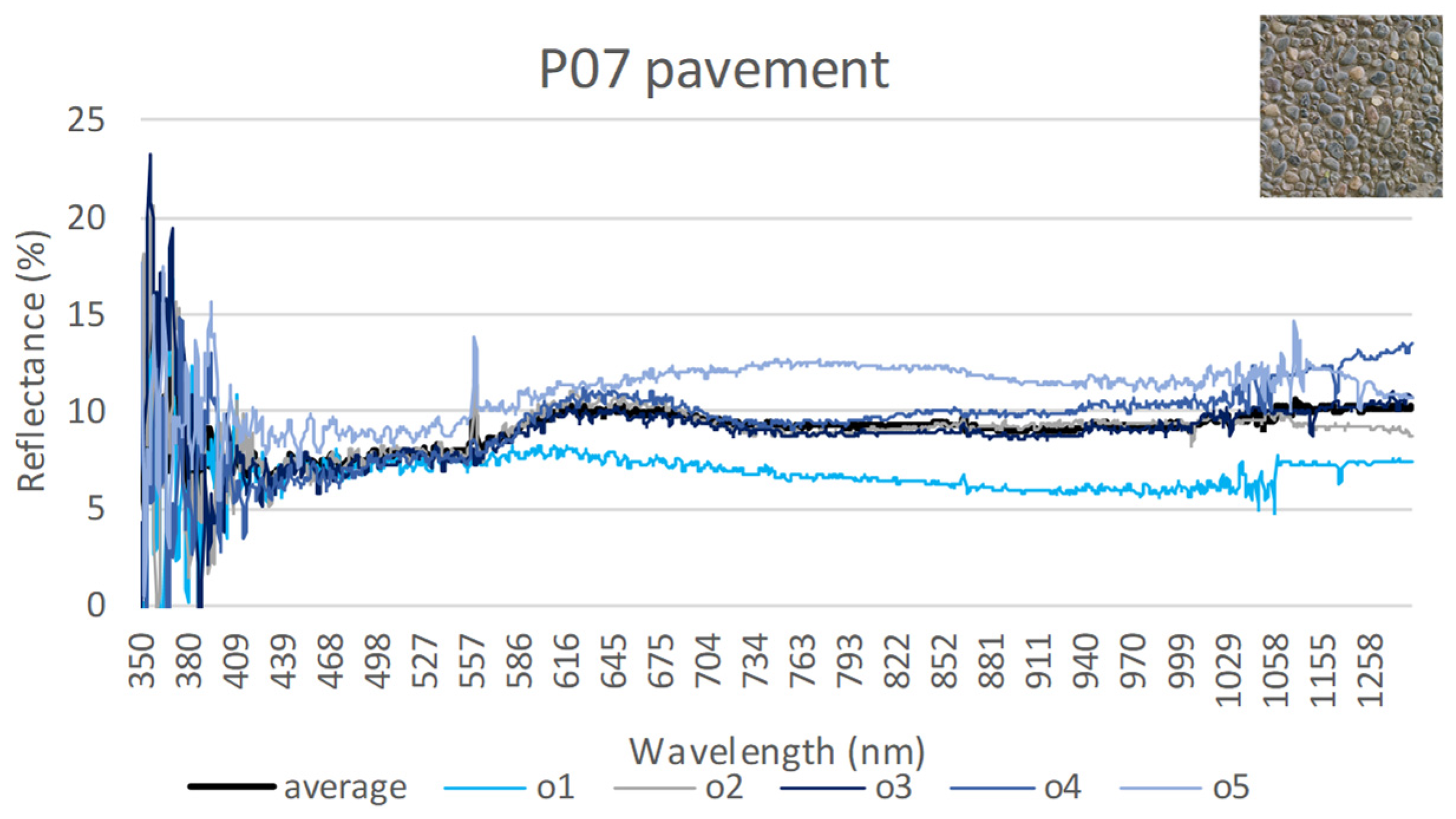


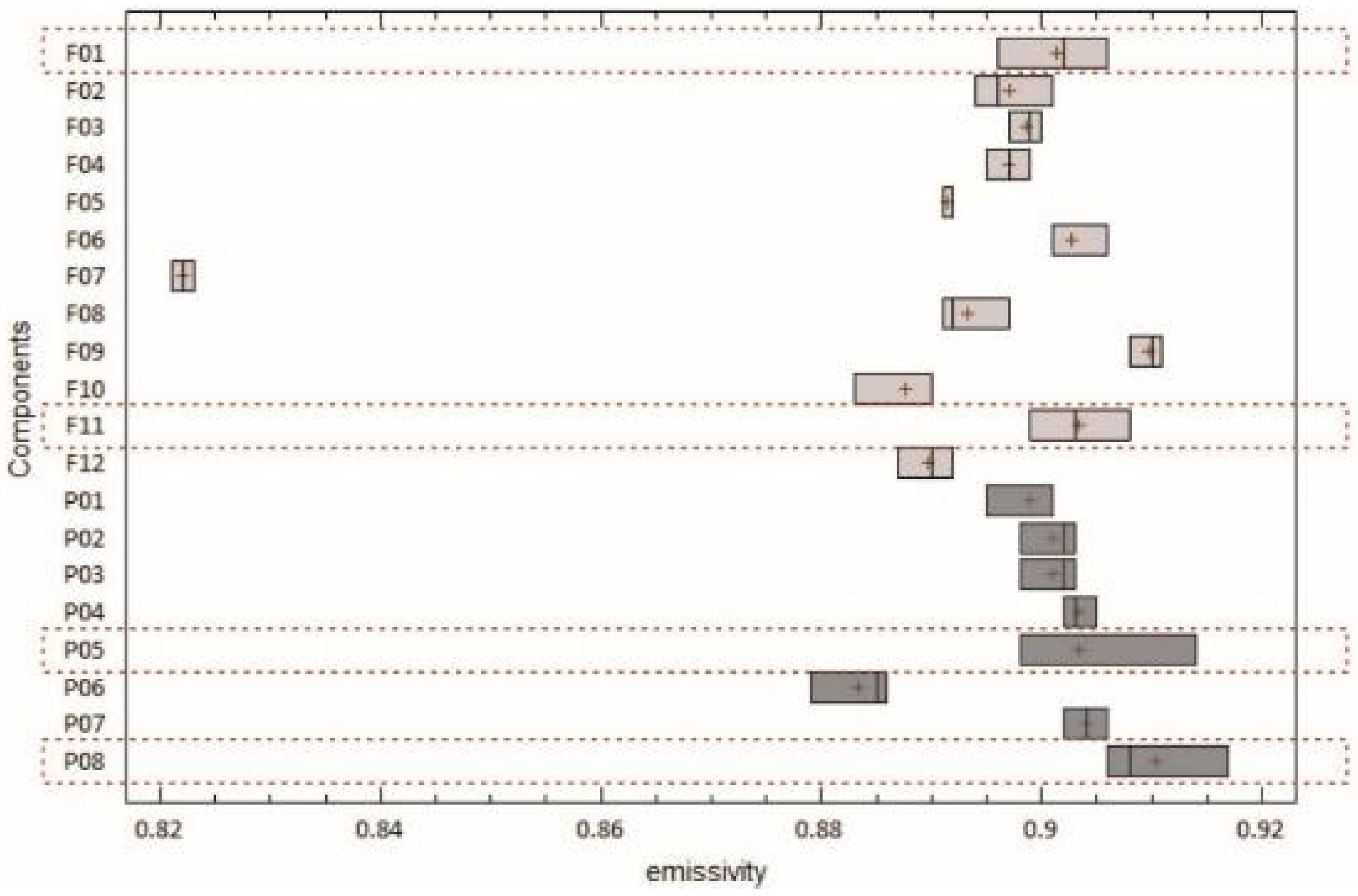

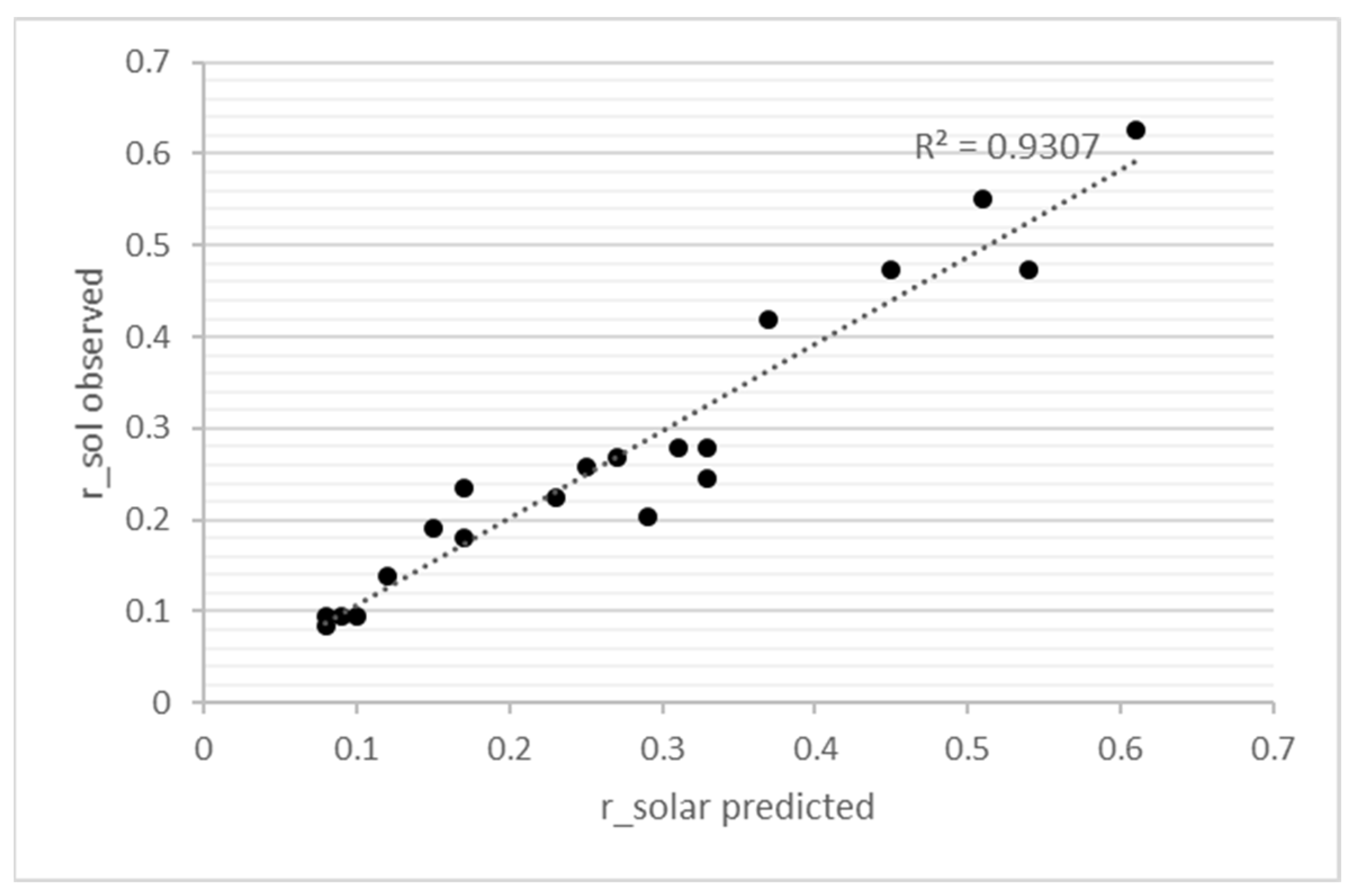
| ID | Façade Type | Reflectance | Color Coordinates | Hemispherical Infrared Emissivity (HTE) | ||||
|---|---|---|---|---|---|---|---|---|
| r_vis | r_sol | L* | a* | b* | ||||
| F01 | Pink textured finish | Ø | 0.57 | 0.61 | 79.35 | 10.60 | 14.99 | 0.90 |
| StDev | 0.04 | 0.04 | 2.27 | 0.93 | 1.21 | 0.01 | ||
| F02 | Ocher textured finish | Ø | 0.43 | 0.45 | 72.69 | 3.85 | 16.23 | 0.90 |
| StDev | 0.07 | 0.08 | 5.01 | 0.41 | 1.41 | 0.00 | ||
| F03 | Orange painted plasterwork | Ø | 0.43 | 0.54 | 67.88 | 29.17 | 49.23 | 0.90 |
| StDev | 0.02 | 0.02 | 0.95 | 1.65 | 2.05 | 0.00 | ||
| F04 | Natural varnished wood paneling | Ø | 0.22 | 0.33 | 50.68 | 11.88 | 36.96 | 0.90 |
| StDev | 0.01 | 0.01 | 1.72 | 1.31 | 1.12 | 0.00 | ||
| F05 | Gray metallic cladding | Ø | 0.38 | 0.39 | 68.02 | 0.68 | 2.14 | 0.89 |
| StDev | 0.00 | 0.01 | 0.18 | 0.01 | 0.84 | 0.00 | ||
| F06 | Blue textured finish | Ø | 0.17 | 0.15 | 48.58 | 0.24 | −5.73 | 0.90 |
| StDev | 0.01 | 0.01 | 0.94 | 0.54 | 0.90 | 0.00 | ||
| F07 | Black metallic cladding | Ø | 0.07 | 0.08 | 32.38 | −0.07 | 1.38 | 0.82 |
| StDev | 0.00 | 0.00 | 1.31 | 0.77 | 1.78 | 0.00 | ||
| F08 | Beige textured finish | Ø | 0.50 | 0.51 | 77.51 | 4.77 | 14.23 | 0.89 |
| StDev | 0.00 | 0.00 | 0.12 | 0.10 | 0.45 | 0.00 | ||
| F09 | Brown textured finish | Ø | 0.12 | 0.12 | 42.25 | 6.30 | 12.85 | 0.91 |
| StDev | 0.00 | 0.00 | 0.47 | 0.73 | 0.97 | 0.00 | ||
| F10 | Varnished exposed brickwork | Ø | 0.18 | 0.26 | 48.18 | 9.26 | 15.68 | 0.89 |
| StDev | 0.01 | 0.02 | 0.40 | 1.16 | 0.12 | 0.00 | ||
| F11 | Terracotta painted brickwork | Ø | 0.25 | 0.33 | 51.87 | 23.13 | 24.10 | 0.90 |
| StDev | 0.01 | 0.01 | 1.44 | 2.06 | 0.95 | 0.04 | ||
| F12 | Black painted stonework | Ø | 0.08 | 0.09 | 33.94 | 1.41 | −3.80 | 0.89 |
| StDev | 0.02 | 0.02 | 4.39 | 0.02 | 1.35 | 0.00 | ||
| Summary | Ø | 0.28 | 0.32 | 56.11 | 8.44 | 14.86 | 0.89 | |
| StDev | 0.02 | 0.02 | 1.60 | 0.81 | 1.10 | 0.00 | ||
| ID | Pavement Type | Reflectance | Color Coordinates | Hemispherical Infrared Emissivity (HTE) | ||||
|---|---|---|---|---|---|---|---|---|
| r_vis | r_sol | L* | a* | b* | ||||
| P01 * | Smooth cement finish | Ø | 0.24 | 0.27 | 55.66 | 2.48 | 8.08 | 0.90 |
| StDev | 0.03 | 0.03 | 2.59 | 1.15 | 0.77 | 0.00 | ||
| P02 * | Pink and beige flagstone | Ø | 0.25 | 0.31 | 54.55 | 7.70 | 11.24 | 0.90 |
| StDev | 0.00 | 0.01 | 0.52 | 1.19 | 0.91 | 0.00 | ||
| P03 * | Gray limestone mosaic | Ø | 0.16 | 0.17 | 47.60 | 1.21 | 4.16 | 0.90 |
| StDev | 0.01 | 0.01 | 1.06 | 0.90 | 0.53 | 0.00 | ||
| P04 * | Red limestone mosaic | Ø | 0.20 | 0.22 | 49.47 | 9.43 | 5.75 | 0.91 |
| StDev | 0.00 | 0.00 | 0.11 | 1.08 | 0.28 | 0.04 | ||
| P05 * | Brushed cement finish | Ø | 0.23 | 0.26 | 55.41 | 3.14 | 8.08 | 0.90 |
| StDev | 0.03 | 0.03 | 3.37 | 0.41 | 1.02 | 0.01 | ||
| P06 * | Black limestone mosaic | Ø | 0.21 | 0.22 | 52.18 | 0.87 | −0.07 | 0.88 |
| StDev | 0.08 | 0.09 | 9.39 | 1.19 | 2.45 | 0.00 | ||
| P07 * | Gray river rock mosaic | Ø | 0.08 | 0.09 | 34.93 | 3.08 | 4.31 | 0.90 |
| StDev | 0.01 | 0.01 | 1.69 | 1.42 | 1.92 | 0.00 | ||
| P08 ** | Asphalt | Ø | 0.08 | 0.08 | 34.59 | 1.12 | 4.03 | 0.91 |
| StDev | 0.03 | 0.02 | 5.67 | 0.25 | 2.01 | 0.01 | ||
| Summary | Ø | 0.18 | 0.20 | 48.05 | 3.63 | 5.70 | 0.90 | |
| StDev | 0.02 | 0.03 | 3.05 | 0.95 | 1.24 | 0.01 | ||
| Façades | ΔL* | Δa* | Δb* | ΔE | Pavements | ΔL* | Δa* | Δb* | ΔE |
|---|---|---|---|---|---|---|---|---|---|
| F01 | 3.21 | 0.2 | 2.98 | 4.38 | P01 | 3.82 | −1.07 | −0.14 | 3.97 |
| F02 | −2.96 | −1.35 | −3.25 | 4.6 | P02 | 3.28 | 0.43 | 0.47 | 3.34 |
| F03 | 2.23 | −2.86 | −0.82 | 3.72 | P03 | −9.75 | −1.45 | −2.25 | 10.11 |
| F04 | −5.74 | −5.95 | −0.98 | 8.32 | P04 | 3.19 | −2.12 | −2.76 | 4.72 |
| F07 | 7.42 | 0.07 | 1.28 | 7.53 | P05 | 15.29 | −4.38 | −5.55 | 16.84 |
| F08 | 5.07 | −1.27 | −0.51 | 5.25 | P07 | −4.91 | −3.96 | −5.18 | 8.16 |
| F09 | 1.99 | −0.86 | −0.5 | 2.23 | P08 | 3.56 | 0.23 | 2.08 | 4.13 |
| F10 | −1.12 | −3.26 | −4.58 | 5.73 | |||||
| F11 | 2.86 | −1.59 | −1.97 | 3.82 | |||||
| F12 | 12.71 | 2.1 | −2.87 | 13.19 |
| Statistics | r_sol Observed | r_sol Predicted |
|---|---|---|
| Count | 20 | 20 |
| Average | 0.27 | 0.27 |
| Standard deviation | 0.16 | 0.16 |
| Coefficient of variation | 58.9% | 58.7% |
| Minimum | 0.08 | 0.08 |
| Maximum | 0.61 | 0.63 |
Disclaimer/Publisher’s Note: The statements, opinions and data contained in all publications are solely those of the individual author(s) and contributor(s) and not of MDPI and/or the editor(s). MDPI and/or the editor(s) disclaim responsibility for any injury to people or property resulting from any ideas, methods, instructions or products referred to in the content. |
© 2025 by the authors. Licensee MDPI, Basel, Switzerland. This article is an open access article distributed under the terms and conditions of the Creative Commons Attribution (CC BY) license (https://creativecommons.org/licenses/by/4.0/).
Share and Cite
Alchapar, N.; Martín-Consuegra, F.; Villalba, A.; Alonso, C.; Pezzuto, C.; Frutos, B.; Pérez, G. Effective and Affordable Methodologies for the Optical Characterization of Envelope Materials Within Urban Contexts. Urban Sci. 2025, 9, 57. https://doi.org/10.3390/urbansci9030057
Alchapar N, Martín-Consuegra F, Villalba A, Alonso C, Pezzuto C, Frutos B, Pérez G. Effective and Affordable Methodologies for the Optical Characterization of Envelope Materials Within Urban Contexts. Urban Science. 2025; 9(3):57. https://doi.org/10.3390/urbansci9030057
Chicago/Turabian StyleAlchapar, Noelia, Fernando Martín-Consuegra, Ayelén Villalba, Carmen Alonso, Cláudia Pezzuto, Borja Frutos, and Gloria Pérez. 2025. "Effective and Affordable Methodologies for the Optical Characterization of Envelope Materials Within Urban Contexts" Urban Science 9, no. 3: 57. https://doi.org/10.3390/urbansci9030057
APA StyleAlchapar, N., Martín-Consuegra, F., Villalba, A., Alonso, C., Pezzuto, C., Frutos, B., & Pérez, G. (2025). Effective and Affordable Methodologies for the Optical Characterization of Envelope Materials Within Urban Contexts. Urban Science, 9(3), 57. https://doi.org/10.3390/urbansci9030057








